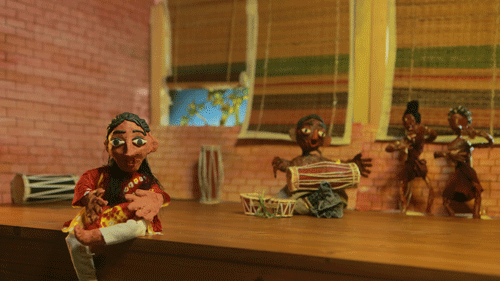Using puppets and animation to tell their stories on screen

A still from the award-winning film on dancer Thaji Dias
When we think of animation we easily think of Disney or Pixar or animation for children …..but wouldn’t instantly think of it as a medium to talk about very serious or traumatic histories of a country,” says illustrator and experimental animator Irushi Tennekoon.
A self-taught professional artist, Irushi has won major international awards and next weekend at the Lionel Wendt, (August 6 and 7 from 10 a.m to 8 p.m.) three of her new films which turn the spotlight on inspiring women – part of the ‘Animate Her’ stop motion animated series will be screened for the public along with an exhibition of her work.
The films are on Lakmini Wijesundara, Anya Ratnayaka and Ramani Muttettuwegama as well as an award-winning film on Thaji Dias.
So how did it all begin? Irushi, a habitual doodler often creating comics of her own, was encouraged by friends to share her creations on Facebook in 2012.
She started on stop motion animation in 2016 whilst doing her Masters in English Studies. Using a basic stop motion app she had downloaded and using household items around her, Irushi experimented with techniques and taught herself the intricacies of the art form. Since then, she’s built her artistic career having illustrated several children’s books and screened her animated short films both locally and internationally whilst balancing her career as a lecturer in English at the University of Colombo.
One of the most labour-intensive forms of animation, in stop motion the stories are told through countless pictures taken of physical objects with paper and plasticine clay cut and shaped with Irushi’s charming puppets positioned and repositioned meticulously between frames to create the illusion of movement once the pictures are placed in sequence and played back.
Her first stop motion film was with collaborators, Sumudu Athukorale and Sumedha Kelegama on Black July in 1983. Told from the perspective of a Sinhalese man haunted by his involvement in the riots, the gripping 4-minute short film was animated using paper puppets and cutouts against a sepia backdrop with stark imagery. “That is when I realized how powerful the medium of animation is to tell very serious stories,” Irushi says. The short-film gained recognition at the Dhaka Art Summit in Bangladesh in 2018 as part of the ‘One Hundred Thousand Small Tales’ exhibition curated by Sharmini Pereira and was also screened at the inaugural exhibition of the Museum of Modern and Contemporary Art in Sri Lanka.

Irushi Tennekoon above, and right, capturing the likeness of Ramani Muttettuwagama
Irushi’s current work – the ‘Animate Her’ series follows her participation in the ‘Creating Heroines’ International Residency and Workshop for female artists conducted in 2019 by the British Council in Nepal. The workshop looked at who constituted a heroine, particularly South Asian heroines and participants received a grant to pursue a project on this theme. Irushi’s series is seven animated interviews or short films detailing the lives of women who’ve achieved success in their fields.
The line-up is made up of Dr. Asha de Vos – marine biologist, Anya Ratnayaka – wildlife conservationist, Lakmini Wijesundera- tech entrepreneur, Amila de Mel – architect, Sybil Wettasinghe – children’s book author and illustrator, Ramani Muttettuwegama- lawyer and activist and Thaji Dias – dancer and teacher. The first four films on Asha de Vos, Amila de Mel, Sybil Wettasinghe and Thaji Dias have been completed with the film on Thaji receiving two major film awards; Best International Short Film at London’s Screen Power Film Festival and Best National Short Film Award at the Jaffna International Cinema Festival earlier this year.
Originally, Irushi had considered using 2D animation but decided on using stop motion animation primarily while still also incorporating 2D animation for some of the sequences. With stop motion, “the movement is taken with single photographs and that makes the movement staggered and it makes it imperfect and that’s what I’m trying to show – these women we’re featuring are heroines but at the same time they are very human and I feel like stop motion helps to show that in its unique sort of way. With clay animation in particular, the clay will have thumbprints and cracks on it and they’re really not perfect at the end of the day but they’re still amazing. It’s symbolic to show that there are so many imperfections and so many challenges but you can still achieve something amazing.”
Each film is around 3 minutes in duration and captures the likeness of each interviewee by moulding their features with clay as puppets and uses recordings of their voices from each interview to voice the puppets and convey their stories. Irushi and her team are currently completing the final four films and plan to incorporate new elements such as 3D animation for the first time.
Directed and animated by Irushi Tennekoon, the Animate Her series is with Yoshitha Perera as director of photography, Shahdia Jamaldeen, Shenuka Corea, S. Surendran, Gayathri Perera, Shakthi Laknatha, and Venuranga Manage on prop and set fabrication, Dinushika Seneviratne on costumes, Natasha Senanayake on music, Parilojithan Ram on photo documentation and Dileepa Jayakody, Sankha Malwaththa and Buddhika Ranasinghe as editors.
‘Thaji Dias on Traditional Dance’ also featured Natasha Senanayake and Devashrie de Silva on vocals, Daham Anuradha on Sri Lankan drums performance, and Denham Hakel for sound recording. Amrithaa Ketheeshwaran provided vocals for the upcoming ‘Ramani Muttettuwegama on Advocacy for the Disappeared’.
For more, follow irus_dedoodles on Instagram and watch the ‘Animate Her’ series on www.irusdedoodles.com
Searching for an ideal partner? Find your soul mate on Hitad.lk, Sri Lanka's favourite marriage proposals page. With Hitad.lk matrimonial advertisements you have access to thousands of ads from potential suitors who are looking for someone just like you.


